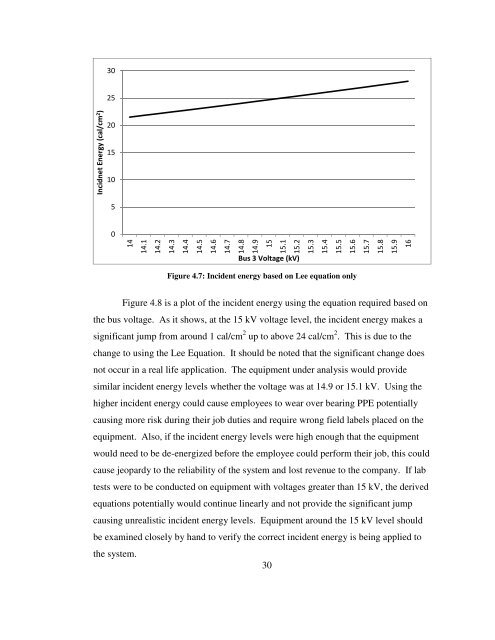arc-flash analysis of utility power systems - Michigan Technological ...
arc-flash analysis of utility power systems - Michigan Technological ...
arc-flash analysis of utility power systems - Michigan Technological ...
You also want an ePaper? Increase the reach of your titles
YUMPU automatically turns print PDFs into web optimized ePapers that Google loves.
Figure 4.7: Incident energy based on Lee equation only<br />
Figure 4.8 is a plot <strong>of</strong> the incident energy using the equation required based on<br />
the bus voltage. As it shows, at the 15 kV voltage level, the incident energy makes a<br />
significant jump from around 1 cal/cm 2 up to above 24 cal/cm 2 . This is due to the<br />
change to using the Lee Equation. It should be noted that the significant change does<br />
not occur in a real life application. The equipment under <strong>analysis</strong> would provide<br />
similar incident energy levels whether the voltage was at 14.9 or 15.1 kV. Using the<br />
higher incident energy could cause employees to wear over bearing PPE potentially<br />
causing more risk during their job duties and require wrong field labels placed on the<br />
equipment. Also, if the incident energy levels were high enough that the equipment<br />
would need to be de-energized before the employee could perform their job, this could<br />
cause jeopardy to the reliability <strong>of</strong> the system and lost revenue to the company. If lab<br />
tests were to be conducted on equipment with voltages greater than 15 kV, the derived<br />
equations potentially would continue linearly and not provide the significant jump<br />
causing unrealistic incident energy levels. Equipment around the 15 kV level should<br />
be examined closely by hand to verify the correct incident energy is being applied to<br />
the system.<br />
30
















